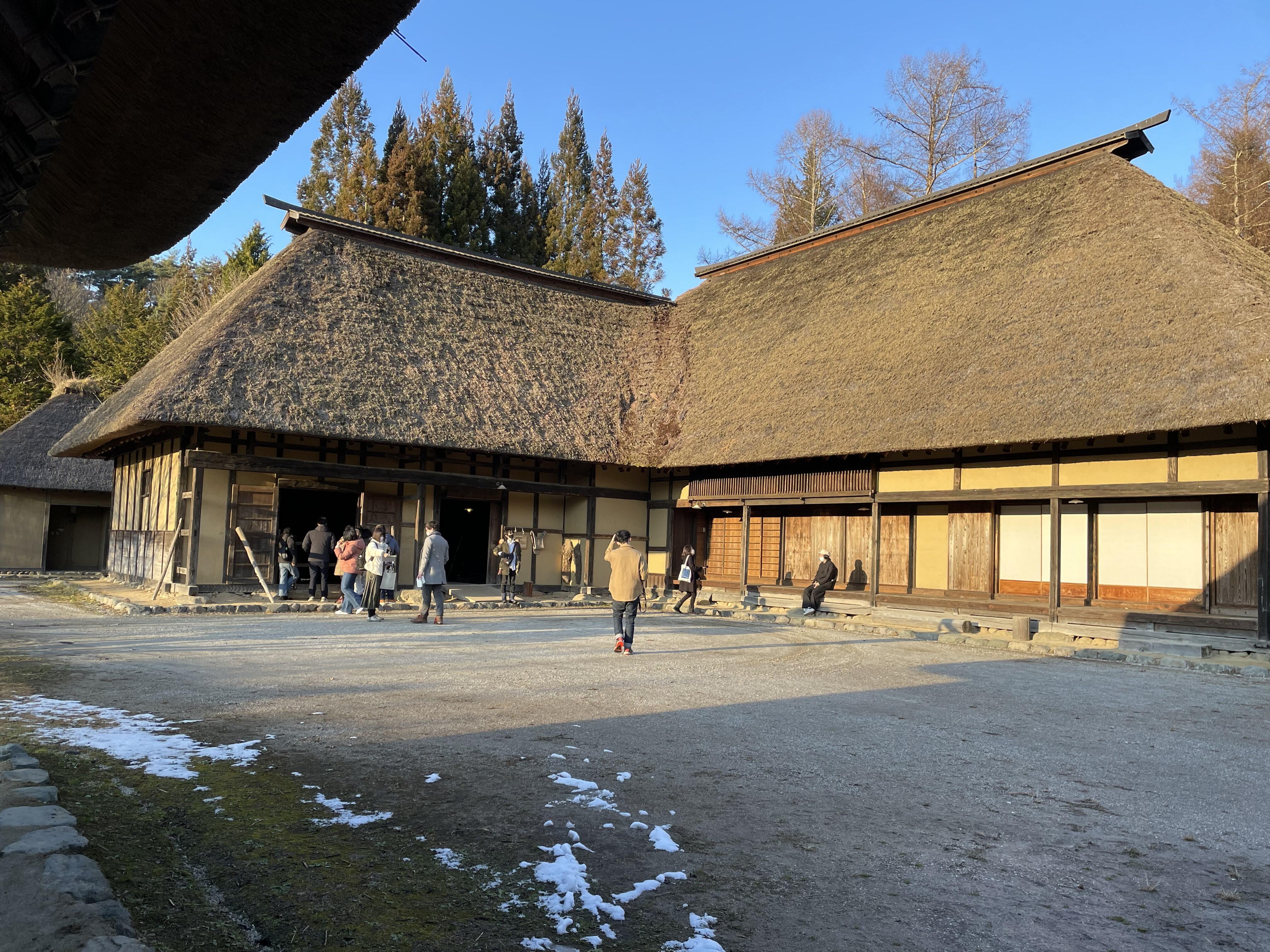お知らせ
- HOME
- ニュース&イベント一覧
- 【国際交流PRアソシエイトからの発信★A Field Trip in Iwate...
【国際交流PRアソシエイトからの発信★A Field Trip in Iwate Tsunami Memorial Museum and Tono Furusato Village】
掲載日2023.1.13
イベント
留学生のレシュミさんは岩手大学が企画した陸前高田市の東日本大震災津波伝承館と遠野ふるさと村へのツアーに参加しました。さて、このツアーでレシュミさんは何を学び感じてきたのでしょうか。レシュミさんの記事をぜひご一読ください。
(言語:英語、ベンガル語)
An international student, Ms. Tabassum Hasnat Reshmi, participated in a tour organized by Iwate University to the Iwate Tsunami Memorial Museum in Rikuzentakata City and Tono Furusato Village. What did Reshmi learn and feel from this tour? Please read her article! (Languages: English, Bengali)
A Field Trip in Iwate Tsunami Memorial Museum and Tono Furusato Village
Written by: Tabassum Hasnat Reshmi
When the word comes to "natural disaster" I can only imagine the picture of thousands of people who lose their houses, destroyed infrastructures, scarcity of food, medicine, and so on. This couldn't be a pleasant situation for any nation. We all know that Japan is an earthquake-prone country. And I am astonished by how Japanese people survive facing earthquakes all around the year as I am afraid of earthquakes most. On December 10, the International Office of Iwate University arranged a field trip to the "Iwate Tsunami Memorial Museum" in Rikuzentakata City and Tono Furusato Village, specially for international students. Many students from China, Korea, Mongolia, Bangladesh, Oman, etc, and some staff from Iwate University went together on the field trip.
The journey began at 7.30 in front of Iwate University Library and around 10.00 we reached the Iwate Tsunami Memorial Museum. A guide was waiting there for us and she welcomed everyone. We followed the guide to the theater room to see a documentary on the Tohoku earthquake and tsunami event. This incident happened on March 11, 2011, with a magnitude of 9 and the earthquake initiated a large tsunami wave that devastated the coastal areas of the Tohoku region. The video documentary showed us how horrible the situation was! A large number of people were moved searching for a safe place. Strong tidal waves destroyed buildings, cars, and roads in just a second. This video was around 12 minutes long and we all can imagine how people suffered during this disaster.
After watching the documentary, the guide showed us some objects that were damaged, some photographs, and the action taken to recure people from Great East Japan Earthquake and Tsunami. I was surprised to know that it only takes two weeks to clean the affected roads but for the nuclear radiation in the Fukushima area, the rescue team couldn't reach there. I could imagine how much difficult to recover from this situation because thousands of homes and infrastructures were destroyed, roads and lines were damaged, electric power was knocked out and water and sewerage systems were disrupted. Lastly, we saw a list of countries that helped Japan to recover from this disaster and I felt proud to see Bangladesh was on the list. There was a beautiful sea beach beside the museum and after saying goodbye to our guide we went to enjoy the scenery of the sea. It is incredible to me how the Tohoku region recovers from this huge damage quickly with the help of inside and outside Japan.
Our next stoppage was Abbasse Takata for taking a lunch break. It was a big place where there were restaurants, super shops, etc, and I ate a delicious Japanese sweet named "Taiyaki" there. After that, we reached Tono Furusato Village at around 14.00. This place was interesting because it was arranged like a real Japanese village. Japanese people like to eat rice like Bangladeshi people, so farming rice is a common occupation between the two countries. This village gave me similar feelings to Bangladeshi traditional village life.
In this village, I came to learn about a Japanese L-shaped traditional farmhouse which is called "magariya". This house was designed to combine with the shelter of farmer's horses. This unique design was made to defeat the Tohoku region's harsh cold and allow the farmers to closely watch their horses. In the middle of this house was a wood-fired clay cooking stove. The heat of the stove kept warm the house. In our country, we use cattle for farming purposes but I observed here in Japan that farmers use horses for farming. Here I was introduced to a mythological character named "Kappa". It looks like a yellow-green shade frog. Basically, Kappa lives in the river and is famous in Japanese folklore.
It was a totally enjoyable day for all of us. I have gathered some valuable information about Japan's great east earthquake as well as the rural culture of Japan. I want to give thanks to the Iwate University International office for arranging such an informative field trip.
যখন "প্রাকৃতিক বিপর্যয়" শব্দটি আসে তখন আমি কেবল হাজার হাজার গৃহহীন মানুষের, ধ্বংসপ্রাপ্ত অবকাঠামো, খাদ্য, ওষুধের অভাব ইত্যাদির চিত্র কল্পনা করতে পারি। এটা কোনো জাতির জন্য সুখকর পরিস্থিতি হতে পারে না। আমরা সবাই জানি জাপান একটি ভূমিকম্পপ্রবণ দেশ। এবং আমি অবাক হয়েছি যে জাপানিরা কীভাবে সারা বছর ভূমিকম্পের মুখোমুখি হয়ে বেঁচে থাকে কারণ আমি ভূমিকম্পকে সবচেয়ে বেশি ভয় পাই। ১০ ডিসেম্বর, ইওয়াতে বিশ্ববিদ্যালয়ের আন্তর্জাতিক অফিস বিশেষ করে আন্তর্জাতিক ছাত্রদের জন্য রিকুজেনটাকাটা সিটি এবং টোনো ফুরুসাতো গ্রামে "ইওয়াতে সুনামি মেমোরিয়াল মিউজিয়াম"-এ একটি ফিল্ড ট্রিপের ব্যবস্থা করেছিল। চীন, কোরিয়া, মঙ্গোলিয়া, বাংলাদেশ, ওমান, ইত্যাদি থেকে অনেক শিক্ষার্থী এবং ইওয়াতে বিশ্ববিদ্যালয়ের কিছু স্টাফ একসঙ্গে ফিল্ড ট্রিপে গিয়েছিল।
যাত্রা শুরু হয় সকাল ৭.৩০ মিনিটে ইওয়াতে ইউনিভার্সিটি লাইব্রেরির সামনে এবং প্রায় ১০ টার দিকে আমরা ইওয়াতে সুনামি মেমোরিয়াল মিউজিয়ামে পৌঁছাই। সেখানে একজন গাইড আমাদের জন্য অপেক্ষা করছিলেন এবং তিনি সবাইকে স্বাগত জানালেন। আমরা তোহোকু ভূমিকম্প এবং সুনামির ঘটনার উপর একটি ডকুমেন্টারি দেখতে থিয়েটার রুমে গাইডকে অনুসরণ করলাম। এই ঘটনাটি ১১ মার্চ, ২০১১ তারিখে ঘটেছিল, যার মাত্রা ছিল ৯ এবং ভূমিকম্পটি একটি বড় সুনামির তরঙ্গ শুরু করেছিল যা তোহোকু অঞ্চলের উপকূলীয় অঞ্চলগুলিকে ধ্বংস করেছিল। ভিডিও ডকুমেন্টারি আমাদের দেখিয়েছে পরিস্থিতি কতটা ভয়াবহ! বিপুল সংখ্যক মানুষ নিরাপদ স্থানের সন্ধানে সরে গেছে। শক্তিশালী জলোচ্ছ্বাস মাত্র এক সেকেন্ডের মধ্যে ভবন, গাড়ি এবং রাস্তা ধ্বংস করেছে। এই ভিডিওটি প্রায় ১২ মিনিটের ছিল এবং আমরা সবাই কল্পনা করতে পারি যে এই দুর্যোগের সময় লোকেরা কীভাবে ক্ষতিগ্রস্থ হয়েছিল।
ডকুমেন্টারিটি দেখার পর, গাইড আমাদের কিছু ক্ষতিগ্রস্থ বস্তু, কিছু ফটোগ্রাফ এবং গ্রেট ইস্ট জাপান ভূমিকম্প এবং সুনামি থেকে লোকেদের পুনরুদ্ধারের জন্য নেওয়া পদক্ষেপগুলি দেখিয়েছিল। আমি জেনে অবাক হয়েছিলাম যে ক্ষতিগ্রস্ত রাস্তা পরিষ্কার করতে মাত্র দুই সপ্তাহ সময় লাগে কিন্তু ফুকুশিমা এলাকায় পারমাণবিক বিকিরণের জন্য উদ্ধারকারী দল সেখানে পৌঁছাতে পারেনি। আমি কল্পনা করতে পারি যে এই পরিস্থিতি থেকে পুনরুদ্ধার করা কতটা কঠিন কারণ হাজার হাজার বাড়ি এবং অবকাঠামো ধ্বংস হয়ে গেছে, রাস্তা এবং লাইন ক্ষতিগ্রস্ত হয়েছে, বৈদ্যুতিক শক্তি ছিটকে গেছে এবং পানি ও পয়ঃনিষ্কাশন ব্যবস্থা ব্যাহত হয়েছে। সবশেষে, আমরা জাপানকে এই দুর্যোগ থেকে পুনরুদ্ধার করতে সাহায্যকারী দেশগুলির একটি তালিকা দেখেছি এবং আমি গর্বিত বোধ করেছি যে এই তালিকায় বাংলাদেশ রয়েছে। মিউজিয়ামের পাশে একটি সুন্দর সমুদ্র সৈকত ছিল এবং আমাদের গাইডকে বিদায় জানিয়ে আমরা সমুদ্রের দৃশ্য উপভোগ করতে গেলাম। এটা আমার কাছে অবিশ্বাস্য যে কিভাবে তোহোকু অঞ্চল জাপানের ভিতরে এবং বাইরের সাহায্যে এই বিশাল ক্ষতি থেকে দ্রুত পুনরুদ্ধার করে।
আমাদের পরবর্তী স্টপেজ ছিল আব্বাসে তাকাতা দুপুরের খাবারের বিরতি নেওয়ার জন্য। এটি একটি বড় জায়গা যেখানে রেস্তোরাঁ, সুপার শপ ইত্যাদি ছিল এবং আমি সেখানে "তাইয়াকি" নামে একটি সুস্বাদু জাপানি মিষ্টি খেয়েছিলাম। এর পরে, আমরা প্রায় দুপুর ২টায় টোনো ফুরুসাতো গ্রামে পৌঁছলাম। এই জায়গাটি আকর্ষণীয় ছিল কারণ এটি একটি সত্যিকারের জাপানি গ্রামের মতো সাজানো হয়েছিল। জাপানিরা বাংলাদেশিদের মতো ভাত খেতে পছন্দ করে, তাই ধান চাষ দুই দেশের মধ্যে একটি সাধারণ পেশা। এই গ্রামটি আমাকে বাংলাদেশের ঐতিহ্যবাহী গ্রামের জীবনের অনুরূপ অনুভূতি দিয়েছে।
এই গ্রামে, আমি একটি জাপানি এল-আকৃতির ঐতিহ্যবাহী খামারবাড়ি সম্পর্কে জানতে এসেছি যার নাম "মাগরিয়া"। এই বাড়িটি কৃষকের ঘোড়ার আশ্রয়ের সাথে একত্রিত করার জন্য ডিজাইন করা হয়েছিল। এই অনন্য নকশাটি তোহোকু অঞ্চলের কঠোর ঠান্ডাকে পরাস্ত করতে এবং কৃষকদের তাদের ঘোড়াগুলিকে দেখে রাখার জন্য তৈরি করা হয়েছিল। এই বাড়ির মাঝখানে ছিল কাঠের তৈরি মাটির রান্নার চুলা। চুলার তাপ ঘর গরম রাখত। আমাদের দেশে, আমরা চাষের উদ্দেশ্যে গবাদি পশু ব্যবহার করি তবে আমি এখানে জাপানে লক্ষ্য করেছি যে কৃষকরা চাষের জন্য ঘোড়া ব্যবহার করে। এখানে "কাপ্পা" নামে একটি পৌরাণিক চরিত্রের সাথে আমার পরিচয় হয়েছিল। এটি দেখতে হলুদ-সবুজ ব্যাঙের মতো। মূলত, কাপ্পা নদীতে বাস করে এবং জাপানি লোককাহিনীতে বিখ্যাত।
এটি আমাদের সবার জন্য একটি সম্পূর্ণ উপভোগ্য দিন ছিল। আমি জাপানের গ্রেট ইস্ট ভূমিকম্পের পাশাপাশি জাপানের গ্রামীণ সংস্কৃতি সম্পর্কে কিছু মূল্যবান তথ্য সংগ্রহ করেছি। আমি ইওয়াতে ইউনিভার্সিটি ইন্টারন্যাশনাল অফিসকে ধন্যবাদ জানাতে চাই এমন একটি তথ্যপূর্ণ ফিল্ড ট্রিপের ব্যবস্থা করার জন্য।











